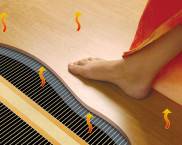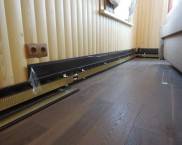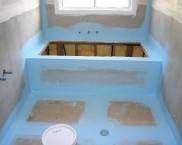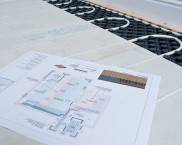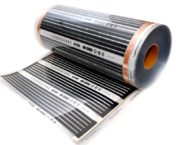Warm floor under the tiles - which is better?
When a real estate owner chooses which is the best warm floor for tiles, the main task is to maintain a rational combination of resource, initial costs, energy savings and reduce the operating budget for floor use.
The content of the article
Video: warm floor: pros and cons
Types of floors, characteristics, pros, cons
A home craftsman who does not have a specialized education and experience in operating additional heating systems extremely needs to know which is better warm floor under the tiles for specific operating conditions. With the invention of superplastic adhesives, tiles can be glued to multilayer 18 mm plywood, and not only on concrete, mortar screeds.
Therefore, underfloor heating systems can be located in an adhesive or concrete layer, which significantly affects the heating intensity of the tiled surface.
Water
Since the tiles are mounted on adhesives, any TP circuit will be embedded in the floors by default. Water pipes have a too large diameter in comparison with heating cables, electric mats, therefore they cannot be laid in the adhesive layer. They are embedded in the screed, reducing the maintainability to zero, so all circuits are pieces of whole pipes without connections from the supply line to the return.
The question of which is the best water-heated floor under the tiles should be divided:
- water TP or electrically conductive?
- which pipe to use to increase the resource?
If for the last question the answer is unambiguous - a pipe made of cross-linked PE-X polyethylene, connected by sliding sleeves from the manufacturer Rehau, then for the first one it is necessary to take into account the factors:
- in apartments it is forbidden to connect TP circuits to central heating without obtaining an appropriate permit from the hot water supplier;
- installation and operation of a separate water heater will dramatically increase the operating budget, instead of saving the customer will receive cost overruns;
- therefore, this option is more suitable for cottages with autonomous heating systems;
- the screed seriously loads the interfloor floors, “eats up” 7 - 12 cm of the working space.
The latter point is very relevant for apartments in which the joint venture standards prescribe the level of the finished floor in bathrooms, toilets and toilets lower than in other rooms, in case of a possible breakthrough in the water supply system. After all, the TP circuits are usually mounted in rooms with the specified functionality.
Important! A quick elimination of possible leaks is impossible in principle, therefore there is always a risk of flooding the lower levels.
Electrical TP
Manufacturers provide warranty obligations for electrical transformer substations within 5 - 10 years. The maintainability of additional heating systems remains low, since to replace a burnt-out cable or mat, you will have to open the tiles in separate areas.
The main advantages of electric TP are:
- no possibility of flooding neighbors;
- easy installation, reduced initial repair budget;
- compact equipment, the ability to integrate inside the adhesive layer directly under the tile.
Important!The heating cable will have to be embedded in the screed, but the layer thickness here is less than that of the TP water circuits. Consultation with the electricity supplier may be required if the allocated capacity is insufficient for the heating cable.
Electrically conductive
The height of the cake of TP systems is similar to the water circuits, however, it is not necessary to supply power to the centralized heating. The pipes are filled antifreeze, only electricity is consumed. There is no need to obtain special permits, but the operating budget will be higher.
When choosing this technology, it will be useful to calculate the strength of the floors, since the load on them from the screed will also be significant.
Features and installation diagrams, comparative analysis
When choosing a warm floor for a tile, which is better, you should take into account the nuances of installation and operation technologies:
- Water contours.
The surface of the dust-free overlap is covered with a film or roll fusion waterproofing material. The edge of the canvas is wound up on the walls, a damper tape is glued over it. The heat from the TP circuits must be stored indoors, therefore, waterproofing insulation is laid (high density EPS or XPS expanded polystyrene).
Further options are possible:
- profile mats - the pipe is clamped with built-in bosses, can be laid in any configuration;
- foil film made of foamed polyethylene - reflects radiation energy, increases the efficiency of the system, a wire mesh is lined on top of it, to which pipes are tied with wire twists.
The TP circuits are pressed before filling with excess pressure, after which it is reduced to working pressure, the mixture is laid and compacted with a vibrating screed. To speed up the process, beacons are mounted, along which the solution is aligned with the rule.
- Electroconductive TP.
To make a decision - which is the best electrically conductive warm floor under tiles and porcelain stoneware, the following factors affect:
- installation is similar to the previous case;
- the system is already pressurized, labor costs are reduced during installation.
The leading manufacturer of electrically conductive TP is Hot Tube, the manufacturer's assortment includes modifications for any premises.
- Electric.
When choosing a resistive TP, you will have to calculate the circuit, select the power of the conductor, and take into account the allocated power of the object.Systems using cables (regular and self-regulating), mats, films are much more convenient:
- a ready-made set of the required power is purchased;
- all information on installation is in the instructions;
- buy only thermostats.
The TP system is laid on the substrate and embedded in a layer of tile adhesive, which reduces the loss of height in the premises.
Related article:
Wiring diagrams of water heated floors in a private house. What are the schemes for underfloor heating? What are the advantages of each type? Which one is right for you? Read on!
Tips, recommendations
When solving the problem, which is better to choose a warm floor under the tiles, depending on the design of the screed, you should take into account the nuances:
- the budget version of the mats is only comfortable heating, but not full heating;
- for the same area, the cable is cheaper than the mat from any manufacturer, the resource is at least 2 years longer;
- a combined electrically conductive floor (a heating cable inside a tube filled with antifreeze) has an average cost, the contour pitch is similar to a water floor.
Cheap single core heating cable is usually used in simple circuits as both ends must be routed to a thermostat. Loops of complex configuration can be made with two-core cables - one end fits to the adjustment equipment, on the other it is enough to put a jumper with a plug.
When choosing a self-regulating cable, the local heating of the floor covering may not be the same throughout its entire length. This will allow you to use energy economically.
Thus, in apartments it is more rational to use electrically conductive, infrared or electric underfloor heating systems under the tiles. In country houses, the operation of a water transformer is cheaper.
Video: warm floor under the tiles
























